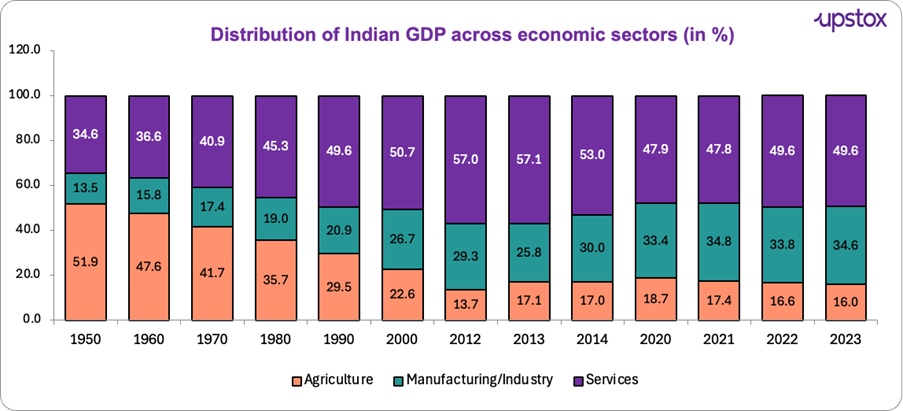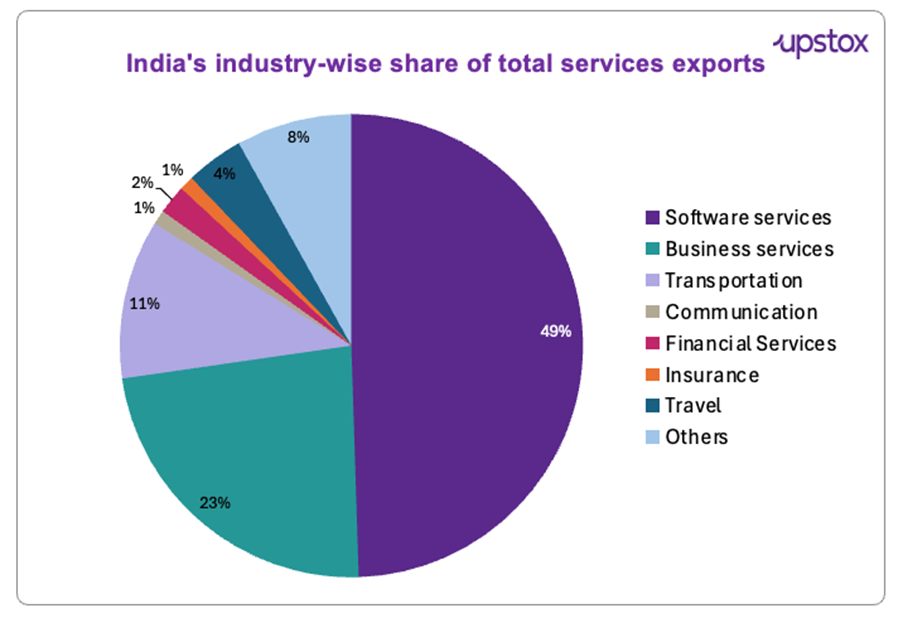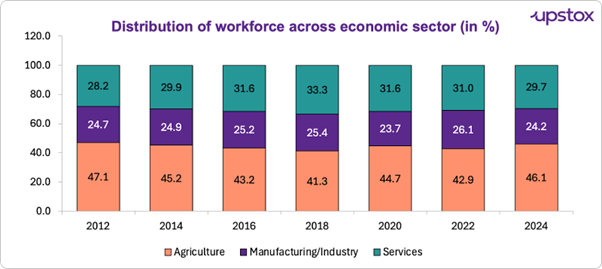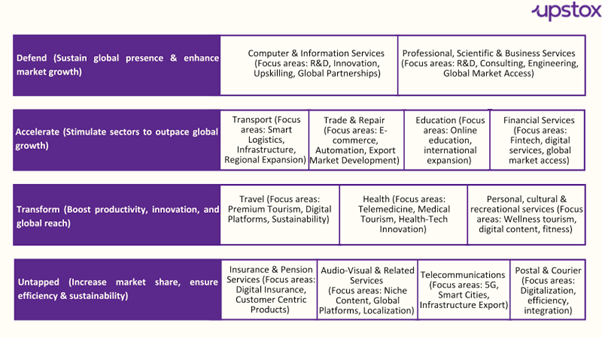Upstox Originals
India’s service sector: The war horse gallops ahead
.png)
5 min read | Updated on April 29, 2025, 13:43 IST
SUMMARY
The Economic Survey 2024-25 calls India’s service sector the “Old War Horse”—a key driver of growth, contributing ~55% to GDP, ~30% to employment, and 43% to exports. Over the past decade, it has sustained or improved its share, yet lags behind developed economies where services exceed 70% of GDP. From IT and fintech to healthcare and digital services, India’s service sector is evolving in the age of AI and automation.

India's service sector accounted for almost 55% of the GDP in FY23
The service sector isn't just a cog in the wheel of India’s economy - it is the wheel, propelling growth both at home and on the global stage. It has been the driving force behind GDP expansion, stepping up even as manufacturing struggles. With services exports strengthening India’s external balance and industries increasingly embracing ‘servicification,’ the sector’s influence has never been more vital.
But what exactly is a service? Unlike physical products, services come with their own unique characteristics, often summarized as the Five I’s:
-
Intangibility: Services aren’t physical. You can’t touch, store, or transport them like goods.
-
Inseparability: They are produced and consumed simultaneously - you can’t take a haircut home for later.
-
Inventory: No stockpiling here! Services can’t be stored for future use.
-
Inconsistency: Every service experience is unique - no two meals or customer interactions are exactly the same.
-
Involvement: A service isn’t just delivered; it’s co-created by both provider and consumer.
India's services sector is the engine of economic growth, powering GDP in 54.7% FY23 - up from just 34.6% in 1950. From finance to tech, it’s shaping the nation’s future.

Source: Statista
Exports from India’s services sector: Key industry-wise contributions
-
Dominance of IT & Business Services: Software services (49%) and business services (23%) lead India’s services exports, driven by strong IT outsourcing, consulting expertise, and a skilled workforce.
-
Other Key Sectors: Transportation (11%), travel (8%), and financial services (4%) contribute significantly due to increasing global trade, rising tourism, and India's expanding fintech ecosystem.
-
Diverse Contributions: Insurance (2%), communication (1%), and other services (1%) play smaller roles, but emerging trends like digital finance, online education, and telecom advancements are driving future growth.

Source: Geeksforgeeks
How does India compare to global economies?
India’s services-led growth model stands in contrast to countries like China, which built its economy on manufacturing exports. But India has unique strengths - a skilled workforce, a global IT presence, and a fast-growing digital economy.
Source: Central Intelligence Agency
Unlike China, India isn’t relying on factories - it’s betting on technology, knowledge, and AI-driven innovation.
India’s workforce shift
India’s workforce underwent an unexpected shake-up in 2024. The once-thriving service sector has slipped from 31% in 2022 to 29.7% in 2024. This rare dip signals potential challenges - automation, slower job creation, or shifting economic priorities. But the concern is the slight decline in the industrial sector, which has dipped from 26.1% in 2022 to 24.2% in 2024.
While manufacturing and industry-driven job creation continue to contribute significantly, factors such as automation, global trade shifts, and increased reliance on imports may be influencing the slowdown.
Interestingly, the agriculture sector saw a reversal—growing from 42.9% in 2022 to 46.1% in 2024. This increase suggests a shift back to traditional employment, possibly due to economic uncertainties, rural employment schemes, or distress migration from urban centers.
As employment patterns shift, India’s growing reliance on agriculture raises critical questions. Is job creation in AI, fintech, and healthcare moving fast enough? Can manufacturing bounce back? The future of India’s workforce will hinge on strategic investments in high-growth sectors, skilling initiatives, and policy-driven workforce planning.

Source: Statista
India’s economic engine is evolving, but the recent workforce shifts signal a need for focused strategies - reskilling, investment, and a stronger push toward future-ready industries.
The future of India’s services: Key growth areas
For India to sustain its leadership, it must move beyond traditional IT outsourcing and expand into next-generation services.
The next phase for India’s service sector is not just about growth - it’s about adaptation and innovation. To remain competitive, the sector must leverage digital infrastructure, enhance workforce skills, and embrace advancements in AI, fintech, and healthcare.
A well-defined strategy focused on emerging industries can strengthen exports, drive economic resilience, and position India as a key player in the evolving global services landscape.
Strategy for service sector
India’s services sector is a powerhouse, driving growth, employment, and exports. But how can we unlock its full potential? That’s exactly what NITI Aayog’s working paper, “Identifying Potential Service Sub-Sectors: Insights from GVA, Exports, and Employment Data,” explores. It studies the potential of services in transforming the Indian economy from various dimensions such as the contribution to output/value added, employment and exports.
Based on the analysis of the performance of the various service sub-sectors on these key dimensions, the Survey classifies services into four categories, each with its own set of policy recommendations: defend, accelerate, transform, and untapped.

Source: Economic Survey of India 2024-25
In summary
India’s service sector has been a pillar of progress, but standing still is not an option. As AI reshapes industries, global markets evolve, and workforce expectations shift, the sector must reinvent itself to stay ahead. The challenge isn’t just growth—it’s about building a future-ready ecosystem that fosters innovation, inclusivity, and resilience. The question isn’t where the sector stands today, but how boldly it will step into tomorrow.
About The Author
Next Story
